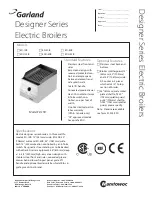
55
Part 8 - Gas Connections
A. Gas Pipe Sizing Tables
1. Gas Pipe Sizing
This information is for reference use only. Refer to gas pipe manufacturer
specifications for actual delivery capacity. The DOE standard for Natural
Gas is 1100 BTU/ft
3
. Contact the local gas supplier for actual BTU/ft
3
rating.
2. Natural Gas Pipe Sizing
The following tables list maximum capacity of pipe in cubic feet of
gas per hour for gas pressures of 14” or less and a pressure drop of 0.5
inches water column, based on a 0.60 specific gravity for natural gas.
Pipe Size (in.)
Length of Pipe (Feet)
BTU’s Per Hour x
1,000
Schedule 40
Metallic Pipe
(0.60 Specific
Gravity,
0.5 WC Pressure
Drop)
10
20
30
40
50
60
80
100
150
200
3/4
360
247
199
170
151
137
117
104
83
71
1
678
466
374
320
284
257
220
195
157
134
1 1/4
1390
957
768
657
583
528
452
400
322
275
1 1/2
2090
1430
1150
985
873
791
677
600
482
412
2
4020
2760
2220
1900
1680
1520
1300
1160
928
794
3
11300
7780
6250
5350
4740
4290
3670
3260
2610
2240
4
23100
15900
12700
10900
9660
8760
7490
6640
5330
4560
Table 21 - Natural Gas Delivery Capacity - Refer to ANSI Z223.1 - National Fuel Gas Code, Latest Edition
3. LP (Liquid Propane) Gas Pipe Sizing
Contact gas supplier to size pipes, tanks, and 100% lockup gas pressure
regulator. Adjust propane supply regulator provided by the gas
supplier for 14 inches w.c. maximum pressure.
B. Gas Connection Requirements
1. The gas connection fitting is ¾” NPT.
NOTE:
The gas pipe size must not be less than ¾”.
NOTE:
DO NOT USE 1/2” quick flex gas lines! Doing so will result in
improper appliance operation.
2. The supply line must be sized for the maximum input of the boiler
being installed. If there are additional gas appliances on the main
supply line, measure the size of the supply line according to the
COMBINED total maximum BTUH draw for the appliances as if they
were operating at the same time.
3. Measure the length of the gas supply line from the gas meter to the
boiler. The boiler must be installed downstream of the gas meter to
ensure adequate gas supply. Use the tables in this manual or refer
to the gas line manufacturer’s sizing information to determine the
correct supply pipe size.
4. The National Fuel Gas Code (NFPA 54) requires that a sediment trap
(drip leg) be installed in the gas line on boilers not so equipped.
The drip leg must be accessible, a minimum of 3” in length, and not
subject to freezing conditions. See Figure 56.
5. A manual gas shut-off valve should be installed in the gas supply
line close to the boiler. See Figure 56.
6. To facilitate any future maintenance, it is also recommended that an
approved gas union fitting be installed in the supply line between
the shut-off valve and the ¾” NPT connection on the boiler.
FIRE AND/OR EXPLOSION HAZARD
To avoid serious injury or death, the gas line
installation and the gas line inlet pressure test
must be done by a licensed professional.
Ensure the gas on which the boiler will operate is the same type specified
on the rating plate (natural gas or LP gas). This boiler must be converted
to propane operation. Follow Gas Conversion Manual instructions
(separate document). Failure to follow these instructions could result in
property damage, personal injury, or death.
Make sure the gas line pressures are within normal limits. Pressures
outside normal limits can result in poor performance and hazardous
operating conditions, property damage, personal injury, or death.
WARNING
WARNING
Do not operate the boiler on Natural Gas or LP gas with average sulfur
rates greater than 30 mg/m3. Doing so could result in improper
product operation and failure, and WILL VOID the boiler warranty.
NOTICE
Figure 56 - Gas Line with Shut-Off and Sediment Trap Detail
Manual Gas
Shut-off Valve
Sediment
trap
Union
Содержание FTVN
Страница 98: ...98 Maintenance Notes...
















































